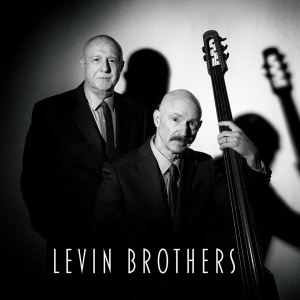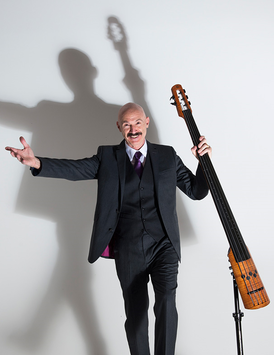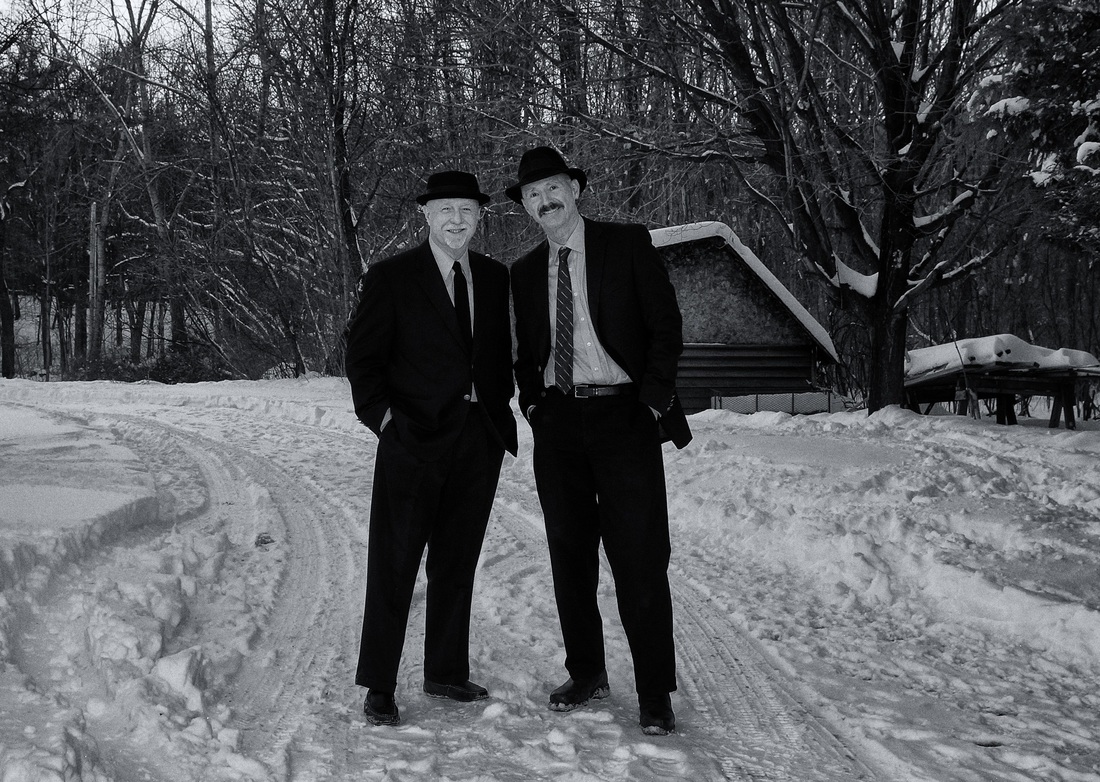
Now the two brothers have joined their talents and their love of “cool 50s” Jazz to record an album that is composed by the two of them (with one notable exception) and is an extraordinary venture into the musical world they have loved since childhood. The results are truly rewarding.
I was given the great opportunity to interview Tony Levin before the release of the album while he is in the midst of rehearsing for the “Elements” tour of King Crimson. Below is that interview.
Travis: Tony, thank you for taking the time to answer a few questions as you are in the middle of a hectic schedule rehearsing for the King Crimson “Elements” tour. I’m going to try to sound like a seasoned music journalist instead of a gushing fan, so please bear with me.
Q: You have played and recorded with everybody who is anybody from Carly Simon and Paul Simon to Burt Sommer and Andy Summers to Peter Gabriel and – I suspect – the Archangel Gabriel. How is it that you got the call to appear on John and Yoko’s “Double Fantasy” and “Milk & Honey?” Can you tell again what were the now-famous words that Lennon said to you at your introduction? And what was your response?
TL: I never really heard why they chose me to play on John and Yoko's album… John said in a radio interview that he wanted another bassist, who was busy and couldn't do it. When I first met him at the studio, his words to me were 'They tell me you're good, just don't play too many notes." I responded, "Don't worry, I won't" and kind of smiled, knowing that he might think I'm a real technical player but would soon hear that I'm a pretty 'bassic' bassist.
Q: You and Pete wrote all the material for “Brothers” with the sole exception of “Matte Kudasai” from King Crimson’s “Discipline” album. Out the vast amount of material that you performed with King Crimson, how did this particular piece make the cut for “Brothers?” I mean, I can understand how “Thela Hun Ginjeet” didn’t get chosen. But what made “Matte Kudasai” your choice?
TL: My first thought was to give people listening to the album at least one song they might have heard before, though our new ones are easy to get the hang of.. and especially King Crimson fans, who might be checking out jazz for their first time. The song itself is a great one, as is evident in the way it lent itself to our instrumental treatment -- not every composition can hold up to different style than the original. Put simply, it's a beautiful melody, and that's what we were looking for on this album.
Q: Speaking of King Crimson for a moment, you are just about to kick off the “Elements” tour with the eighth—count ‘em, EIGHTH—incarnation of King Crimson and this time with three drummers, no less. Crimson has gone with two-drummer line-ups before but how is it for you to be part of a 4-person rhythm section?
TL: It's pretty wild, having 3 drummers, as you'd expect. The surprise is that they have done a great job of fashioning interesting drum approaches that never fall back on all three guys just pounding away. Amazingly there's no clutter - and sonically you hear some fills go across the room (the 3 drummers are at the front of the stage, with the rest of the band behind!) So for me as bassist, it's been a relief to hear there's still room for me in the rhythm picture(!) And I think, for audiences, enjoying the drummers both visually and in audio, will be a big part of the fun of the show.
Q: Staying with drummers, you have played with the pantheon of progressive rock drummers: Bill Bruford, Terry Bozzio, Alan White, Gavin Harrison and Pat Mastelotto. Who was the one—or was there one—who challenged you or intrigued you the most and why?
TL: I have indeed been lucky to play with a number of great drummers, those you've mentioned and more. I don't compare them (nor do I compare any musical elements) - there are similarites and differences, as with all us players. The joy of making music happens easier when you are around great players, so it's ver special when a bass player has the chance to groove with, and learn from, a great drummer.
Q: As I stated, 15 of the 16 tracks on “Brothers” were written by you and Pete. I have heard you talk about your writing style as one of distancing yourself from almost everything. How did your composing style work with Pete’s personal style of composing?
TL: We were clear from the start that we wanted to do an album honoring, and harkening back to the cool jazz albums we loved when we were kids. Specifically those of bassist/cellist Oscar Pettiford and French Horn player Julius Watkins. (That's the instrument Pete played first.) It's amazing how well we both remembered the songs and solos from those albums, even some 50 years after hearing them… and I felt, that's what you really want to aim at with your music; songs that are so right that they'll become part of the listeners musical vocabulary forever. Can't say that we'll succeed with that, but it's worth shooting for. So our songs are quite melodic, with standard form, and the solos are pretty short - - you play your best ideas and move aside for the next player. That makes for tracks that are 3 minutes or so long… we could fit a lot more songs on the album than usual, and it provides for a variety of music. (And, a bonus, when we decided to also make a vinyl LP of the music, we could fit 11 songs onto it -- pretty impossible with the prog rock epics I'm used to playing!)
Q: Who are the guest musicians on “Brothers?” Of course, Steve Gadd is pretty hard to conceal.
TL: We were lucky to get sax player Erik Lawrence. He plays a lot of gigs with Pete, as does drummer Jeff Siegel, and Pete, Jeff and I did some warm up gigs before going into the studio. Guitarist David Spinozza has played on tons of jazz albums (including in the group "L'Image" with me) and we wanted him on guitar on the pieces where Pete plays organ. Steve Gadd and I were in school together, and he's largely responsible for mentoring me in jazz, so it just seemed right to bring him in for the track "Bassics" which features bass and drums. We've played on a lot of albums and tours together through the years, and I think you can hear that connection in the music.

TL: The idea at first was for my cello to have the lead on the songs, and sometimes Pete's organ. But as the songs developed, we found the piano was just better on some songs, and on some I wanted to stay with bass, so having a sax player with a sweet warm sound to take the lead would help the song. Erik turned out to be perfect for that. And, yeah, there are a couple tracks where we let the bass be the lead instrument - somewhat for the novelty of it.
Q: “Mysterioso” sounds like a film noir soundtrack, like from an Edward G. Robinson or Humphrey Bogart movie. What inspired that piece and the cool sax part?
TL: Pete wrote that, and, yes, the sax is very special. That gritty, soulful sound is a requirement on a song like that - we love Erik's playing, and can't wait to head out on the road with him and the band.
Q: “Not So Square Dance” has snippets and variations from all kinds of familiar pieces. What was the evolution of that song? Maybe I’m wrong but I thought I heard a variation of “Mama’s Little Baby (Loves Shortenin’Bread)” and I certainly heard “Shave and a Haircut.”
TL: Yeah, some musical jokes in there -- again it's a piece Pete wrote, and his sense of humor comes through in many ways. The writing was pretty straightforward on that one -- he wrote it the way it was recorded. Some other songs of ours had more of an evolution - especially the ones I instigated, where I was happy to have Pete improve on the chords I'd selected to go with my melody.
Q: An absolute delight is the piece “Havana!” Who is carrying the vocals? You? Sounded like you from the King Crimson Barbershop Quartet.
TL: Hah..! Well, it's an old tradition to have the bass player sing along with his bowed bass… call it a tip of the hat to Slam Stuart. I had fun with it, and luckily had a bit of a cold that day, enabling me to get down to the low 'A'. (or close to it!)
Q: “I Got Your Bach” is a cool turn on the Cello Suite, No. 1 in G major. You certainly prove that Bach can groove with the best of them. What can you tell me about this piece? I’m not kidding when I say that it brought tears to my eyes (I mean that in a good way).
TL: Maybe it's because I'm a bass player, trying cello as a new thing, but I couldn't help fooling around with that great piece as I was practicing the cello. And once I'd tried it with a jazz feel, writing a melody to go above it was an easy thing. I did hesitate about putting it on the album (we recorded more than could fit) because a part of me though that real cellists might cringe - but, hey, I'm a bassist dabbling in cello, so I guess I'm allowed to mess with Bach!
Q: Your use of the cello on several tracks is very moving. ”When Sasha Gets the Blues” is especially moving. Where did the title originate? It made me think of Sasha Abramsky’s book “Hard Times Blues.” Am I way off?
TL: I had in mind a friend of ours from Russia, but like any song titles or lyrics, it works best if the listener applies his own spin to make it work.
Q: Lastly, and thank you very much for your patience, can we look forward to more straight-up Jazz from the two of you together? You are undoubtedly the master of the progressive rock genre but you have turned in a stunning and memorable—even emotional—Jazz recording. Please tell me there is more to come!
TL: Next year we'll tour with the group -- probably jazz clubs (which I love to play in) but it's too early to say for sure. And, of course, I'll keep touring and recording with my Stick Men, with King Crimson, and if I'm lucky, with Peter Gabriel too.
Travis: Thanks so much again for your time, Tony. And thank you for all the great performances and recordings. I’ll be seeing you and King Crimson on September 23rd in Madison!
TL: Great, I'll look for you there. Thanks!

 RSS Feed
RSS Feed
